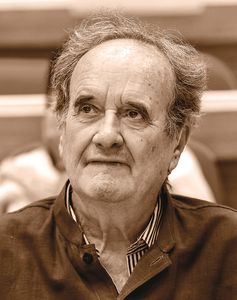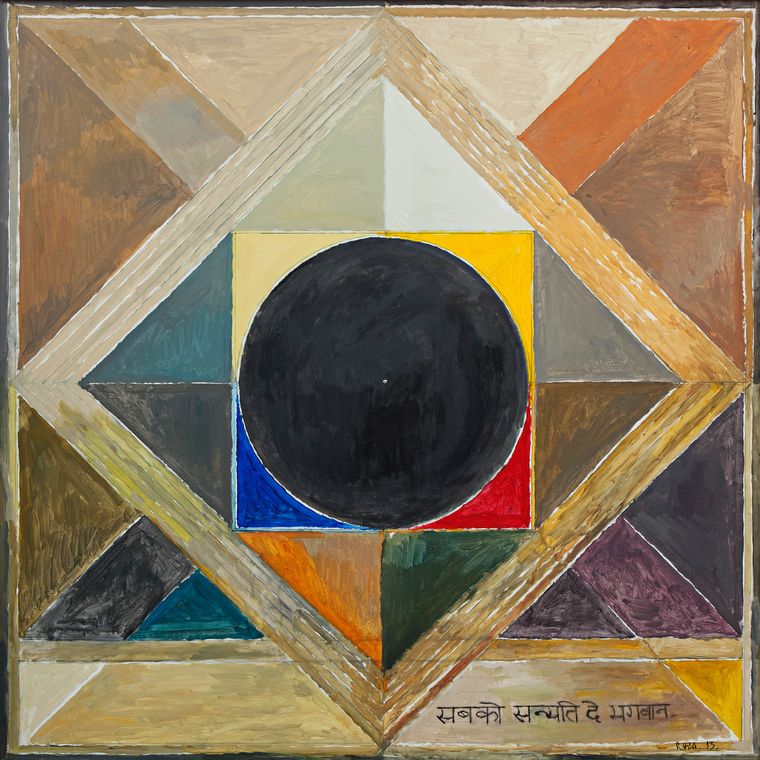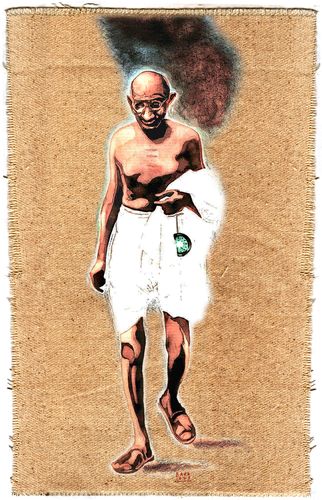Since 1996 a portrait of Mahatma Gandhi in his last years has adorned Indian currency notes. On the notes in my wallet, underneath the portrait, in very small print, is written Mahatma Gandhi in English and Hindi. I doubt whether that identification is necessary; so well known is the face with trademark rimless spectacles. When I looked at the portrait more carefully, I noticed that Gandhi was smiling slightly. It is a quizzical smile, as though he is saying, “What on earth am I doing here?” Were Gandhi to find himself in India now I believe he would almost certainly ask that question.
In the first place he would be surprised to be associated with the money which keeps the wheels of modern India’s economy turning. With its inequality, its corruption and its consumerism, its obsession with growth without concern for how India is growing and who benefits from the growth, it represents all that Gandhi opposed.
At the same time Gandhi would not like to be given the title Mahatma. He once said, “Often the title has deeply pained me and there is not a moment I can recall when it may be said to have tickled me.” He maintained he had become “literally sick of the adoration of the unthinking multitude.” He even felt humiliated by some of the adjectives used to describe him because he had to confess he didn’t deserve them.
Canonising Gandhi has done him no favours. Inevitably the demolition squad has moved in, determined to knock the Sant off his pedestal. In recent times Arundhati Roy has argued that Gandhi’s nonviolence was based on “acceptance of the most brutal social hierarchy ever known, the caste system”. On the other hand, the scholar Nishikant Kolge in his recent book Gandhi Against Caste, published by Oxford University Press, maintains “at times Gandhi was clearly against caste, and at other times ambivalent.” Even when ambivalent, Gandhi had economic and social reasons for his ambivalence. The journalist Joseph Lelyveld’s biography of Gandhi hit the headlines because of the suggestion that Gandhi might have been gay. The historian Patrick French thought that was highly unlikely. He argued that Gandhi “was one of the best documented figures of pre-electronic times and has been the subject of innumerable biographies, so managing to be gay without anyone noticing until now would be a remarkable feat.” It would also make Gandhi a monstrous hypocrite considering how openly he talked about his sexuality and his reverence for brahmacharya, which he said included “full control over the process of reproduction.”
Patrick did, however, bring Gandhi down to earth by reducing the satyagraha he pioneered to clever or cunning tactics and reducing Gandhi himself “to someone who was above all a wily operator and tactician who knew how to undermine the British, when to press one’s advantage and when to withdraw”. Patrick also quoted a British governor who said Gandhi was “as cunning as a cart load of monkeys.”
The other problem which arises from granting the status of a Sant to anyone is that the person sanctified is removed from reality or, to put in another way, becomes no longer a real person. The Sant is made out to be so remarkable that to follow his or her example appears beyond the range of possibilities for mere mortals. They stare up at the Sant’s statue in wonder and then walk on. This is what has happened to Gandhi. He is revered but not followed in his own country. It’s almost as if India feels it has done its duty by granting Gandhi such an elevated status and now it can go on and live as any other nation does.
It’s not as though Gandhi has been totally forgotten. Numerous biographies of him have been written and doubtless there are more to come. There are departments of Gandhian studies in universities and institutions dedicated to those studies, too. In Kerala there is an Institute of Nonviolence. But Gopal Gandhi has surely got it right when in the introduction to his biography of his grandfather he said, “Repetition has made one of the world’s most compelling, transformational and passionate persons the one thing he never was, boring. It has made the most original person clichéd.” One of Gopal Gandhi’s aims in getting Gandhi to tell his own story through selected passages from his works has been “to redeem the living Gandhi from the plaster-cast image of the Mahatma”. Gopal Gandhi has included Gandhi’s own vivid description of the time he lost his temper with Kasturba and almost threw her out of the house. It shows that Gandhi was no plaster-cast saint.
What is there that the living Gandhi has to teach India today? He certainly has something to say about the relationship between religion and politics, as a deeply religious man himself. He once wrote: “It is faith that steers us through stormy seas, that moves mountains, faith that jumps across the oceans. That faith is nothing but a living wide-awake consciousness of God within.” But Gandhi’s view of the relationship between religion and politics did not coincide with either of the two conflicting views which have led to the sterile battle between secularism and hindutva that has dominated Indian politics for so long.
Unlike the secularists, Gandhi did not believe in the separation of religion and politics. He could hardly have done so being religious and also deeply involved in politics. It’s not surprising that he believed, “Those who say that religion has nothing to do with politics do not know what religion means.” He believed religion should “pervade” politics. But this religion would lead to “an ordered moral government of the universe.” It was a religion which, as he put it, “transcends Hinduism, Islam, Christianity, etc. It does not supersede them. It harmonises them and gives them reality.”
Hindutva does not conform to Gandhi’s political philosophy or his religious faith either. The general election has demonstrated that it has become the dominant ideology of Indian politics. Were he to have lived as an Indian now Gandhi would not have approved of the divisive Hinduism of the Modi campaign in the general election. He would have regarded the abusive language of both sides as a breach of ahimsa or nonviolence. M.S. Golwalkar, the second person to head the RSS and one of the most influential hindutva ideologues, stressed his belief in the unifying power of Hinduism, in contrast to the secularist belief that religion was dangerously divisive if it was involved in politics. Golwalker maintained it was “the grand world-unifying thought of Hindus alone that can supply the abiding basis for human brotherhood.” This knowledge, he said, is “in the custody of Hindus alone”.
Gandhi believed that all the major religions had made unique contributions and were unique visions of God. He was a great admirer of the teachings of Jesus with his emphasis on a loving God and his understanding of suffering. He admired Islam’s stress on monotheism and equality. When one of his companions, Madeleine Slade, the daughter of a British admiral, wanted to convert from Christianity to Hinduism he discouraged her, suggesting she remain in the faith she was born into, and borrow what she liked from Hinduism. Gandhi rejoiced in being born as a Hindu. As an Indian he also rejoiced in the fact that almost all the world’s great religions were deeply embedded in his country so he had a unique opportunity to borrow from them.
Gandhi certainly has something to say today about protesting against injustice, or perceived injustice. Because he abhorred violence and committed himself to ahimsa, or nonviolence, he pioneered satyagraha in South Africa as a means of protesting against injustice without resorting to violence. Gandhi’s belief in ahimsa sprang from his Hindu faith. He said, “the most distinctive and largest contribution of Hinduism to India’s culture is the doctrine of ahimsa.” His first satyagraha in India took place in Champaran in Bihar. It was a peasants’ protest against being effectively forced to grow indigo for British planters. The satyagraha forced a reluctant government to set up a committee to examine the farmers’ complaints. The committee’s recommendations were then incorporated in a law. The best known satyagraha of Gandhi was his 240-mile march from Ahmedabad to Dandi, where he defied the salt act. The march was peaceful but Gandhi persuaded large numbers of village officials who were an essential part of the imperial administration to resign. The viceroy wrote to London reporting how dangerous Gandhi’s challenge to the legitimacy of the government had become.
Gandhi sometimes appeared to exaggerate the potentiality of nonviolence, but he did realise that there could be occasions when it was necessary to resort to violence. It has often been suggested that his nonviolence only succeeded because British rule over India was mild when compared with other colonial regimes, and Britain’s hold over India was weakening. But had he felt it necessary, it appears that Gandhi would have been prepared to resort to violence. He did say, “I would rather have India resort to arms in order to defend her honour than that she should, in a cowardly manner, become or remain a hapless witness to her own dishonour.”
Gandhi laid down strict conditions for someone to be a satyagrahi. They included never missing a chance of compromise on honourable terms. For Gandhi compromise was not a dirty word as it is all too often in the fervid atmosphere created by demonstrations and other forms of protest today. Satyagrahis were also to be of good moral character, having a living faith in God, leading a chaste life, abstaining from alcohol and any other intoxicant. Gandhi would certainly disapprove of what passes for satyagraha all too often today and indeed the other forms of protest which are so prone to violence. He might well agree with B.R. Ambedkar who in his final speech at the Constituent Assembly stressed the need for India to hold fast to constitutional methods to achieve its social and economic objectives and went on to say, “... we must abandon the method of civil disobedience, non-cooperation and satyagraha.... Where constitutional methods are open, there can be no justification for these unconstitutional methods. These methods are nothing but the Grammar of Anarchy and the sooner they are abandoned, the better for us.”
Gandhi had a deep-rooted aversion to the civilisation he originally called western, but came to see as a far more general phenomenon which he called modern civilisation. It is well known that he criticised the new amenities science and technology had made available to him such as railways, telegraphs and hospitals; urbanisation too. He once said, “I wholeheartedly detest this mad desire to destroy distance and time to increase animal appetites and go to the ends of the earth in search of their satisfaction.” Hospitals he once described as “institutions of sin” because they enabled people to live intemperate lives and then be cured of the consequences. Gandhi had a pastoral view of the way life should be lived in India. It was tinged with nostalgia for a golden age which never existed, an age of village democracies. He believed there was a time in India “when village economies were organised on the basis of nonviolent occupations, not on the rights of man but on the duties of man.”
Also read
- PM Modi pays homage to Mahatma Gandhi at Rajghat
- Rediscovering peace at Gandhi's Sevagram Ashram
- 'Tatva' of Gandhi's philosophy remains same, 'tantra' will differ
- Mahatma Gandhi's ideas for the world
- Many faces of Gandhi
- The unknown Gandhi: The extraordinary journey from Mohandas to Mahatma
- What Gandhi wanted for India
- Gandhi was not a caste abolitionist: Kancha Ilaiah Shepherd
- Gandhian philosophy needs to be practised: Tushar Gandhi
- Gandhi, Savarkar two irreconcilable poles in Indian history
Gandhi’s yearning for the past, dislike of the present, and fear for the future of what passed for civilisation in his time make him an unlikely person to be chosen as a guide to increasing India’s GDP growth rate. But there are ideas underlying his economic thinking which India and indeed the world would do well to keep in mind.
“Plain living and high thinking” was Gandhi’s motto for life. He opposed the consumerism of his day saying, “The incessant search for material comforts and their multiplication is such an evil, and I make bold to say that the Europeans themselves will have to remodel their outlook if they are not to perish under the weight of the comforts to which they are becoming slaves.”
Gandhi realised that consumerism was based on the encouragement of greed and that greed created not only perpetual dissatisfaction but also envy. The Europeans have not remodelled themselves and if Gandhi were to return he would be horrified to see how far Indians have gone down the consumerist road. He might well remind India and indeed the rest of the world of words said by Krishna in the Gita, “Enveloped by wisdom is this insatiable fire of desire which is the constant foe of the wise.”
We might dismiss Gandhi’s concerns about the moral impact of the technological and scientific advances in his time as excessive, but the underlying principle of them is still highly relevant. He was in effect saying we shouldn’t be led by the nose by science and technology. We should stop to think about the disadvantages as well as the advantages which come with new technologies, the price we pay for adopting them, so that we don’t misuse or overuse them. Take hospitals as an example because Gandhi warned against them. They may not be institutions of sin but they have become dangerous places. According to the World Health Organization, “In high income countries approximately 30 per cent of the patients in intensive care units are affected by at least one health care associated infection.” These infections are often caused by improper or overuse of antibiotics. Antibiotics were discovered by researchers in the 20th century.
We need sometimes to think whether we should even develop a particular line in research. But scientists rarely accept limits to their research on the grounds that it might have dangerous or immoral outcomes. In the 16th century, Leonardo da Vinci suppressed research into inventing the submarine because he thought we humans were too devilish to be trusted with such a dangerous invention. In the 20th century Enrico Fermi, one of the scientists who set out on the atomic bomb project, said, “Don’t bother me with your conscientious scruples. After all the thing is beautiful physics.”
Finally, going back to where I started, I believe that if Gandhi were to come amongst us he would ask two fundamental questions. Where do moral questions and considerations of moral consequences come in today’s politics and economics, science and technology? Where does consciousness of God within, awareness of the sacred, and of the transcendental, come in today’s Hinduism?





